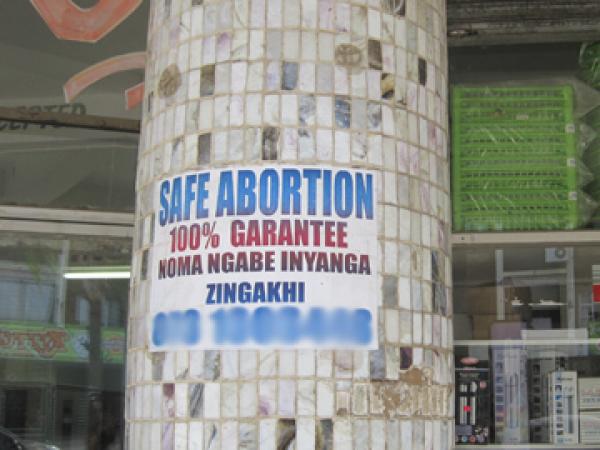Behind the abortion adverts

We see them plastered over walls in town, on stop signs, outside schools and even advertised in local newspapers. But what is the real story behind the 1-hour abortion posters?
I called a number from one of the posters and arranged to meet a man in central Stanger.
The young man, who did not wish to be named, led me down an alleyway and into a dingy waiting room. To the side was a small room covered in red fabric with medicine laid out on the floor. He provides help for many personal issues, and abortion is just one of these.
He said “It’s a business. If you want to eat, you have to do it.”
I said that my friend who wanted the abortion was five months pregnant. While the legal time limit for abortions on demand is twenty weeks, he was prepared to provide the pills for up to six months of pregnancy. He charged R1,000: R200 for every month of pregnancy, the extra cost reflecting the increase in risk.
He explained the procedure: the woman was to take two pills orally, and then insert four pills into her vagina. If there was bleeding she should drink strong tea. He claimed that the pills had been sold to him illegally by a pharmacist at a hospital.
This is not just happening on the streets. Online, I found “Kelly’s clinic”, which boasts branches around South Africa. For R1,100, Mr Kelly was willing to deliver the pills by post, never having examined the patient or verified the story. He also offered a R200 student discount.

Photo by Ruth Atkinson. (Telephone number has been blurred out.)
The pills being sold are mifepristone and misoprostol. The first breaks down the lining of the uterus while the second causes contractions. Visitors to backstreet abortion clinics are left to perform the termination themselves at home, and may later present at hospital with what looks like a spontaneous miscarriage. A potential complication for the mother is that the placenta does not leave the body and becomes infected. This is a septic miscarriage, and can be fatal.
At five months, a premature baby can be born and has a slim chance of survival. There have been cases at Stanger hospital where after a premature birth the midwife has found traces of tablets in the mother’s uterus. The baby often does not survive due to complications. Alex Armitage, a paediatrician at the hospital said, “These women should not be blamed. Their actions are dictated by fear and a lack of information. I feel sorry for the mothers.” Indeed, according to a 2006 study, of the 70% of South African women who were aware that abortion was legal, 48% did not realise there was a time limit involved.
Dr Herbert Ringanayi from Stanger hospital agreed, saying “everyone feels pity for them”. He said that even if women know that free legal abortions are available, often they will visit a backstreet abortionist for assured confidentiality. In a small community, the person who works at the clinic may well know the patient and her family. Another issue, he said, was that a health practitioner’s personal beliefs about the ethics of abortion might conflict with their duty of care to the patient. Therefore the patient might not be given a termination and be forced to seek help elsewhere. It is estimated that 50% of the abortions carried out in South Africa are illegal.
Head of Obstetrics and Gynaecology at the KZN Department of Health, Neil Moran, said, “The best way to combat this problem is to ensure better information and education about safe sexual behaviour and contraception. This must start at home with parents educating their children. If unwanted pregnancies are prevented, then there is no need for termination of pregnancy.”
Support independent journalism
Donate using Payfast

Don't miss out on the latest news
We respect your privacy, and promise we won't spam you.
Next: Laws of physics suspended - prosecutor in Angy Peter trial
Previous: Govt develops new toilet technologies - but how much will they help?

This article is licensed under a Creative Commons Attribution-NoDerivatives 4.0 International License.
